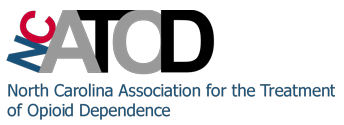Posted by NCATOD on October 9, 2012
By Kristen Hayes, CRC Corporate Communications Director
On Friday, September 14th, the Carolina Treatment Center in Pinehurst, NC held their first community Open House and celebrated National Recovery Month. The facility recently completed an expansion project, so the event included a special ribbon cutting ceremony with representatives from the Chamber of Commerce and the opportunity to tour the facility. They invited community providers to set up informational tables, held raffle drawings, had speakers discuss substance abuse and treatment, and sold food with all proceeds going to benefit a local youth substance abuse prevention program.
Before the event, Clinic Director Amy Morris said, “The goal of this event is to honor those who work in substance abuse prevention and treatment, and people in recovery from substance abuse disorders.”
After the event, Amy wrote in an email: “One year ago, I was given the opportunity to work as Director at Carolina Treatment Center in Pinehurst. I was given the task of taking a facility that had been without onsite leadership and was struggling with a community full of misinformed ideas and stigma. In addition, it was a facility that had outgrown itself. Staff members were sharing offices and niches that had been carved out of corners to work in. During this transitional time, staff morale had reached a low and turnover was astounding. There was much potential in the facility, the staff that had weathered the storm, and the community full of misinformation.
“I made a commitment to the staff to take care of their needs and they made a commitment to offer the highest quality of care and pursue the vision that I had for Pinehurst, even when it seemed daunting if not impossible, from where we stood.
“From January until now, the staff gave 100% and then some more. We embarked on a mission to fill vacant positions only with people who would be part of our goals and would accept nothing but the best from themselves and each other. Countless hours were spent reaching out to the community. There was a conscious effort to directly face the stigma that has always plagued opioid treatment. We dispersed across the law enforcement, prevention, social service, and treatment professionals throughout our county. We completed a renovation that allowed for 1600 square feet of additional treatment space with the help of Ed Ohlinger and Sam Moore. The staff at Carolina Treatment Center is absolutely the most dedicated team I have ever worked with and they do not ask for much in return.
“Last night was the accumulation of a yearlong effort to incorporate ourselves in the treatment community. Overwhelmingly, the response was positive. We were able to shake hands with people who would not take our calls 6 months ago. Parents came and shared their stories with each other and with us. They were thankful that we have opened our doors to the community to show that opiate treatment has a legitimate place and serves a grossly underserved, over stigmatized population. Family members and patients were proud to be part of our efforts and this event. We refuse to act as `the methadone clinic’ that people whisper about and are ashamed to attend.
“I would like to thank the staff at Pinehurst because without their hard work and dedication, none of this would be possible. I would like to thank Ed Ohlinger for giving me a chance to work on his team and allowing me to see a vision through and Sam Moore for his dedication to our expansion and renovations. I thank CRC for their continued commitment to the people we serve and the employees that work in the trenches of OTP treatment daily. With this continued support, Pinehurst has no limits. Keep watching because the best is yet to come.”
Echoed Katie Clark, a research assistant at the Yale School of Public Health who is also working towards her Masters of Science in Public Health at UNC Chapel Hill and was an invited speaker at the event, “I believe that opening the doors and showing the community what actually happens at treatment facilities can really work to reduce the stigma and intolerance that is associated with substance use disorder treatment facilities. I hope the staff are proud of their event. They showed commitment to their community and their patients.”
